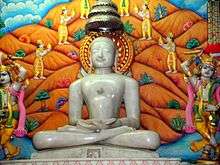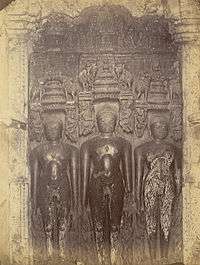Ajitanatha
| Ajitanatha | |
|---|---|
| 2nd Jain Tirthankara | |
 Lord Ajitanatha (Mathura Chaurasi) | |
| Symbol | Elephant |
| Height | 450 bows (1,350 meters) |
| Age | 72 lakh purva (508.032 x 1018 years old) |
| Color | Golden |
| Parents |
|
| Preceded by | Rishabhanatha |
| Succeeded by | Sambhavanatha |
| Born | Ayodhya |
| Moksha | Shikharji |
| Part of a series on |
| Jainism |
|---|
 |
|
Jain prayers |
|
Ethics |
|
Major figures |
|
Major sects |
|
Festivals |
|
Pilgrimages |
|
|
Ajitnatha (lit. invincible) was the second tirthankara of the present age, avasarpini (half time cycle) according to Jainism. He was born to King Jitashatru and Queen Vijaya at Ayodhya in the Ikshvaku dynasty. According to Jain beliefs, he became a siddha, a liberated soul which has destroyed all of its karma.
Life
Ajitnatha (lit. invincible)[1] was the second tirthankara of the present age, avasarpini (half time cycle) according to Jainism.[2]
Ajitnatha was born in the town of Saketa to King Jitashatru and Queen Vijaya at Ayodhya in the Ikshvaku dynasty on magha-shukla-dashmi (the tenth day of the bright half of the month of Magha).[2] His height was 450 dhanusha (1350 meters) and he lived for a span of 72 lakh purva.[1]
He attained kevala jnana under the sal tree and Moksha on chaitra-shukla-panchmi (fifth day of the bright half of the month of Chaitra) from Shikharji.[3][1]
Simhasena was his chief Ganadhara.[1]
As a historical figure
The Yajurveda mentions the name of Ajitanatha, but the meaning is not clear. According to Jain traditions, his younger brother was Sagara. Sagara, who became the second Chakravartin, is known from the traditions of both Hindu and Jain scriptures.[4]
- From the Hindu source: Sagara is known to have had many sons. One of them was Bhagiratha, who brought the river Ganges.
- From the Jain source: In his last days, Sagara adopted the life of asceticism from Ajitanatha and retired from the worldly life.
Ajinatha is associated with his Elephant emblem, Saptha-parna tree, Mahayaksha Yaksha and Yogini & Ajithabala Yakshis.[5]
Literature
The Ajitha purana, by Ranna.
Famous Temple
- Taranga Jain Temple : It is around 900 years old.
- Ajitnath Digambar Jain Atishaya Kshetra Bandhaji
- Vasai Jain Temple in Bhadresar, Gujarat
- Bandhaji
Gallery
-

Tirthankara (possibly Ajitanatha), India, Southern Rajasthan, c. 12th century, marble
-

Ajitnatha idol in Bhand Dewal along with Neminath and Shreyanasanatha dated back to 11th century
-

Ajitnath Tonk, Shikharji
-

Footprint at Ajitnath Tonk, Shikharji
-

Taranga (Jain Temple), Gujarat (1121 AD) constructed by Kumarapala (Solanki king)
-

Paporaji main temple constucted in 1142 AD
-

Ajitnatha idol at Paporaji main temple
-

Vasai Jain Temple
See also
| Wikimedia Commons has media related to Ajitanatha. |
Notes
- 1 2 3 4 Vijay K. Jain 2015, p. 183.
- 1 2 Tukol 1980, p. 31.
- ↑ Krishna & Amirthalingam 2014, p. 46.
- ↑ Jain, Kailash Chandra, Antiquity of Jainism, Jainism Literature Center
- ↑ Tandon 2002, p. 44.
References
- Jain, Vijay K. (2015), Acarya Samantabhadra's Svayambhustotra: Adoration of The Twenty-four Tirthankara, Vikalp Printers, ISBN 978-81-903639-7-6,
 This article incorporates text from this source, which is in the public domain.
This article incorporates text from this source, which is in the public domain. - Krishna, Nanditha; Amirthalingam, M. (2014) [2013], Sacred Plants of India, Penguin Books, ISBN 978-9-351-18691-5
- Tandon, Om Prakash (2002) [1968], Jaina Shrines in India (1 ed.), New Delhi: Publications Division, Ministry of Information and Broadcasting, Government of India, ISBN 81-230-1013-3
- Tukol, T. K. (1980), Compendium of Jainism, Dharwad: University of Karnataka